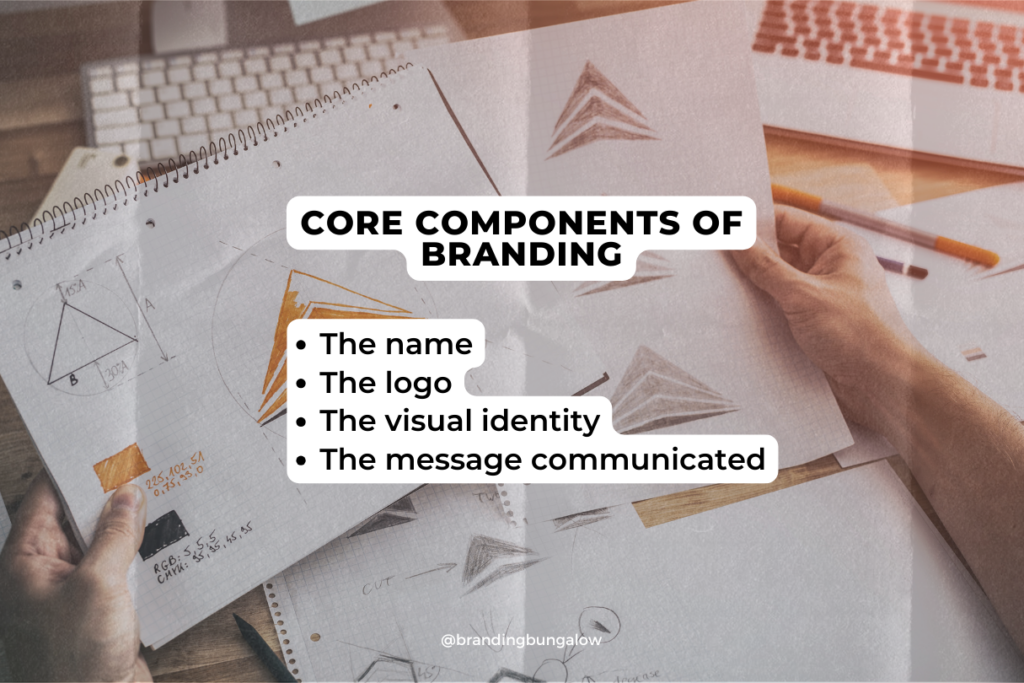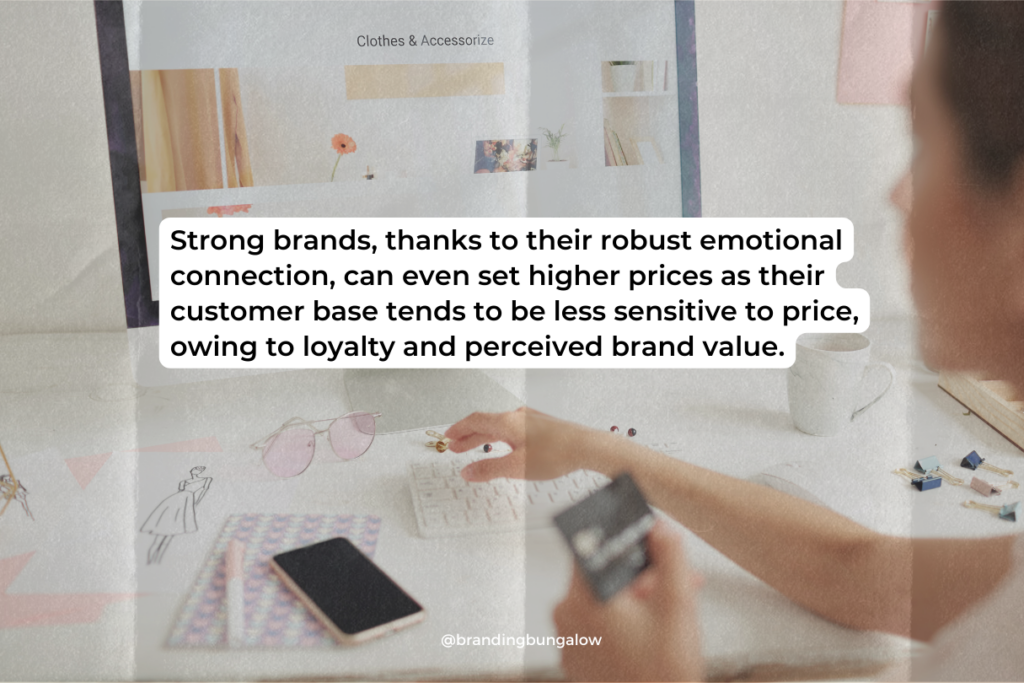Branding Is Key: Elevate Your Business with Brand Strategy
Branding is the intentional effort to shape your product or company’s identity in the market. At its simplest, it’s about crafting a unique name and image that will be etched in the minds of your customers, guiding their preferences and loyalty. Explore with us the tactical insights into establishing a powerful brand, the role it plays in growth, and the reasons why an effective brand strategy can be your greatest ally in the competitive business landscape.
Key Takeaways
- Branding is essential for creating a distinct identity and personality for a business, shaping customer perceptions, and guiding the trajectory of a business, distinguishing it from competitors.
- Successful branding resonates with the target audience, enhances brand trust and recognition, creates an emotional connection, encourages customer loyalty, and can lead to premium pricing due to perceived value.
- Building a strong brand identity involves establishing clear brand values and purpose, developing consistent visuals, researching and understanding the target market, positioning your brand effectively, and continually measuring and optimizing branding efforts to adapt to market trends.
Understanding Branding

At its core, branding is about creating a distinct and consistent identity for a business or product. It’s the process that shapes customer perceptions and guides the business trajectory. Think of a brand as a person. Just like a person has an identity, personality, and experiences, a brand too has its own identity, values, and experiences that it communicates to its audience. It’s what makes businesses memorable and encourages consumers to keep coming back.
Branding separates the wheat from the chaff. It distinguishes a company’s personality and values, unlike marketing, which focuses on promotion and awareness. The key to understanding branding lies in knowing that it provides an identity for a business. It’s what encourages consumers to buy, thereby supporting overall marketing.
Taking time with branding decisions is crucial as it directly impacts how customers perceive a business. It’s like steering the ship; it guides the business trajectory and shapes customer perceptions about the brand. It’s important for a variety of reasons, including shaping how the business is perceived in the competitive marketplace.
The Evolution of Branding
Branding is far from a modern concept. It dates back to 2000 BC when farmers used it to indicate ownership on cattle. As civilizations evolved, branding took on more sophisticated forms. The ancient craftsmen marked their goods to signify origin and quality, which was an early form of branding. Visual signs and storefront paintings were used to communicate about goods for sale to a largely illiterate populace.
Fast forward to the 21st century, and we see branding taking on a whole new dimension. The advent of mass media in the 20th century significantly increased the demand for branded goods. Brands began associating their products with messages of happiness and satisfaction, using mediums like television and radio.
The internet era brought about a focus on interactive techniques, like viral marketing and search engine optimization, for brand development. Today, social media has paved the way for personal branding among celebrities and influencers, widening the landscape of brand strategy.
The Core Components of Branding
Branding, although a broad concept, boils down to a few key components. The pillars on which a brand is built are:
- The name
- The logo
- The visual identity
- The message communicated
The visual identity, expressed through elements like the logo, color palette, typography, and iconography, contributes to its unique design personality.
The brand’s messaging, on the other hand, is the language used to connect with its audience. It reflects the brand’s personality and is designed to resonate with consumers. The brand name and logo are the most visible elements, playing a key role in making the brand memorable and helping it stand out in the marketplace. Consistency in these elements forms the backbone of a successful brand.
The Power of Successful Branding

Branding isn’t just about creating a unique identity for your business. It’s about creating a unique identity that resonates with your target audience. Brand identity refers to making your brand relatable, guiding your business decisions, and maximizing your resources. A well-established brand acts as a compass, guiding decision-making, scaling with the business, and maintaining a consistent vision.
Successful branding enhances the valuations of a business, increasing its market value. It leaves a lasting impression on customers by consistently upholding brand values in everyday business. Strong brands, thanks to their robust emotional connection, can even set higher prices as their customer base tends to be less sensitive to price, owing to loyalty and perceived brand value.
Brand Recognition and Trust
A brand is like a brand promise to the customer. It’s a set of expectations that the customer has from the business, and fulfilling these expectations builds trust. Brand trust is the level of confidence and belief that customers and consumers have in a brand. It reflects the strength of their conviction in the brand’s reliability and credibility. In fact, a staggering 77% of consumers prefer to purchase from brands that share similar values.
Brand recognition, on the other hand, is about how familiar the general public and the target audience are with a brand. Effective advertising plays a crucial role in improving brand recognition as it allows businesses to speak directly to the target audience’s needs. The takeaway here? A distinct brand identity, achieved by being consistent in messaging across all marketing channels, creates trust and clarity with customers.
Emotional Connection and Customer Loyalty
Behind every brand is a story. A story that connects with the audience on an emotional level. Branding’s primary purpose is to create meaningful relationships with customers by selling not just products but experiences, feelings, and ideologies. Brands that manage to create a strong emotional connection enjoy higher levels of loyalty and customer retention.
The secret to forging an emotional connection? Infusing a brand with human characteristics through a well-defined personality. This affects how the brand communicates and connects with audiences, enhancing emotional engagement. Sensory experiences, such as visuals, sounds, and other sensory cues, also play a crucial role in shaping brand perception and forging an emotional connection.
Crafting Your Unique Brand Identity

Building a strong brand identity is no easy task. To succeed, you need strategic planning, creativity, and a deep understanding of your target audience. These skills are essential for achieving your goals. From noting down ideas, choosing a color palette, creating logos, posting on social media, to extending beyond just a visual identity, there are numerous steps involved in the branding process.
A successful brand identity not only appeals to customers but also attracts a larger pool of job applicants by conveying a unique employee value proposition. Employee engagement and productivity are heightened within a strong brand, enhancing company pride and profitability.
Defining Your Brand’s Values and Purpose
What does your brand stand for? What is its purpose? The answers to these questions form the bedrock of your brand’s identity. Brand values are guiding principles that inform a company’s behavior and decision-making, reflecting what is fundamentally important to the organization.
A clear mission statement, on the other hand, defines the purpose and passion of an organization. It’s the driving force behind all decisions and states why the organization exists and why people should care about the brand. These values and the mission statement guide the decision-making process and help differentiate the brand from its competitors.
Developing a Consistent Visual Identity
Visual identity is a crucial part of a brand. It’s what makes a brand instantly recognizable to consumers. Consistency in color palette, logos, and typography is key to enhancing brand recognition and visual identity. These elements should be clearly reflected across the business website, social media profiles, and branded content.
A brand style guide is instrumental in governing the use of visual assets, ensuring accurate and consistent representation of the brand’s identity. Even product packaging plays a crucial role in storytelling and showcasing the brand identity, supporting the overall brand experience.
Implementing a Winning Brand Strategy

Implementing a winning brand strategy involves strategic planning, creativity, and a deep understanding of your target audience. E-commerce branding is crucial to stand out in the digital market and should be reinforced through effective branding guidelines, a well-defined brand strategy, and consistency in branding elements to build equity.
A thorough competitive analysis can also help understand how to make the brand stand out, focusing on the competitors’ strengths and weaknesses to improve the branding approach. To successfully implement a brand, it must be displayed consistently across every marketing tool and all points of customer interaction.
Researching Your Target Market
Understanding the needs and preferences of your target audience is crucial for crafting a brand strategy that resonates with them. Comprehensive market research is fundamental to this process, revealing customer demographics, personas, and buying motivations.
The branding strategies must also be adaptable, utilizing knowledge of ongoing industry trends and shifts in consumer behavior to stay relevant and maintain engagement with the target market.
Positioning Your Brand in the Marketplace
Defining your brand’s position in the market involves:
- Determining how customers perceive your brand in comparison to your competitors
- Differentiating your brand and standing out in the marketplace
- Understanding the target market
- Communicating the unique selling points clearly and consistently.
Brand differentiation is crucial here. It demonstrates the unique aspects of your brand, distinguishing it from competitors. This is important for creating a strong brand identity. This helps establish a strong market position.
Creating Engaging Content and Messaging
Creating engaging content and messaging is about developing a brand voice that connects with the audience. It’s about crafting compelling brand stories that boost marketing efforts and customer engagement.
Ensuring that brand messaging remains relevant requires:
- Regular evaluation and updating to align with evolving market trends and consumer expectations
- Measurement of the impact of branding adaptations on brand perception through key performance indicators and customer feedback
- Refinement of branding strategies based on the evaluation and feedback
Measuring and Optimizing Your Branding Efforts

Measuring and optimizing branding efforts is a critical part of brand management. It involves managing both the tangible and intangible elements of the brand, which is fundamental to tracking and optimizing branding efforts.
This process allows businesses to monitor brand equity and perception and adapt to changing market trends, which helps refine branding strategies and maintain relevance.
Monitoring Brand Equity and Perception
Brand equity reflects a brand’s value and contribution to a company’s success, and can be measured as a separate financial asset. Operational data like sales, finance, and HR data can provide datasets that help measure brand equity quantitatively. In this context, brand valuation plays a crucial role in assessing the overall worth of a brand.
Qualitative aspects of brand equity, such as emotional decisions and perceptions by consumers, are understood through experience data and consumer surveys. Similarly, brand perception is discerned through customer feedback, brand surveys, and other evaluative tools with the aim to track engagement metrics and monitor changes in brand perception over time.
Adapting to Changing Market Trends
Updating branding elements like messaging, visual identity, and tone can help maintain resonance with changing market trends while preserving core brand values. Gradual integration of branding updates across various touchpoints helps avoid confusing existing customers.
Legacy brands can maintain customer recognition by making tweaks that work better with modern design preferences without departing too much from their core brand or following fleeting design fads.
Case Studies: Successful Branding in Action
The power of branding is best understood by looking at real-world examples. Take Coca-Cola, McDonald’s, and Nike, for instance. These brands have achieved remarkable success, largely due to their well-executed brand strategy.
MailChimp, known for maintaining a clear and consistent tone across its brand communications, is another example of successful branding. It has managed to create a distinct identity and a strong branding strategy that resonates with its target audience.
Glossier, a popular beauty brand, is another example of successful branding. Early equity built by content significantly contributed to its successful launch and brand establishment.
These examples illustrate the power of a well-executed brand strategy in driving successful business growth. They show that with the right branding strategy, businesses can create a distinct identity, attract a loyal customer base, and ultimately drive success.
Summary
Branding is the backbone of a successful business. It’s what sets a business apart from its competitors. From creating a distinct identity to shaping customer perceptions and guiding business trajectory, branding plays a crucial role in driving business success.
The key to successful branding lies in understanding the target audience and creating a brand that resonates with them. It involves defining brand values and a mission statement, developing a consistent visual identity, implementing a winning brand strategy, and continuously measuring and optimizing branding efforts. With a well-executed brand strategy, businesses can create a distinct identity, attract a loyal customer base, and ultimately drive business growth.
Frequently Asked Questions
What do you mean by branding?
Branding refers to creating and promoting the brand name, its attributes, and personality, which can be applied to an entire corporate identity or individual products and services.
Why is branding important?
Branding is important because it sets your business apart from competitors, creates an identity, makes it memorable, and encourages consumers to buy. This is why establishing a strong brand is crucial for business success.
What are the core components of branding?
The core components of branding are the name, logo, visual identity, and the message communicated, which are essential for establishing a strong brand presence.
How can I implement a winning branding strategy?
To implement a winning branding strategy, it’s crucial to understand your target audience, define your brand values and purpose, create a consistent visual identity, and continually measure and optimize your branding efforts. By doing so, you can establish a strong and effective brand presence.
Recent Blog Entries
Discounts to Dubsado CRM, Helcim Payment Processing and...
Brand audits can save your business' sinking marketing ship.
What's happening to Coke and what you can learn from it.
Shop Products
Create a personalize brand board by taking elements from our 3 signature brand board templates.